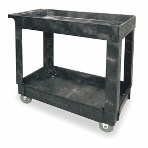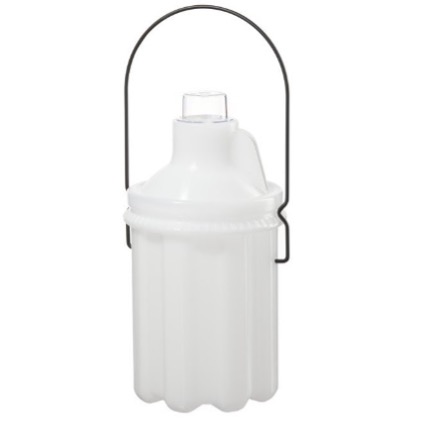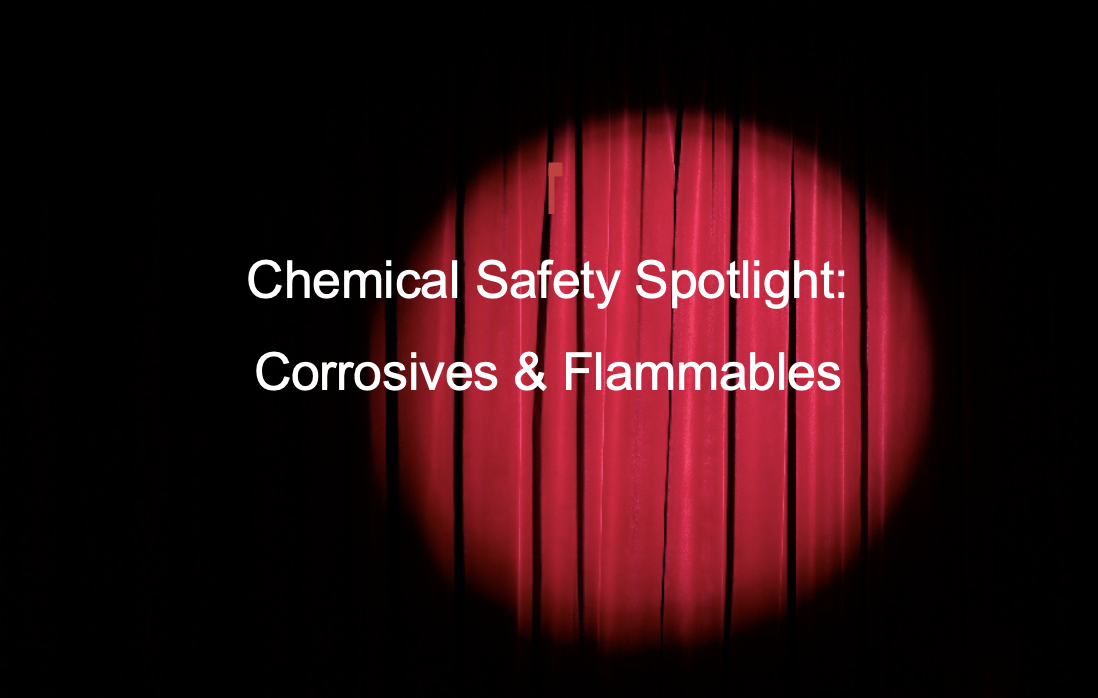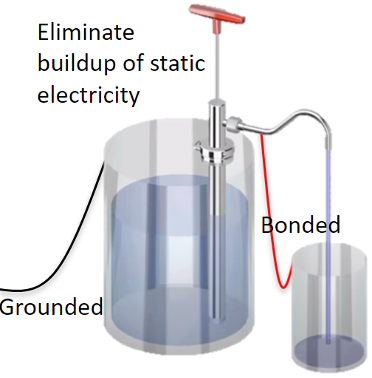CORROSIVES
Corrosives can cause serious damage to the skin, eyes, and respiratory tract. Corrosives can also destroy or react with plastics, metals, and other materials they come into contact with such as clothing and work surfaces. This can include acids (e.g., acetic acid, hydrochloric acid, sulfuric acid), bases (e.g., sodium hydroxide, ammonium hydroxide), and some organic solvents (e.g., phenol).

Storage:
- Store in a corrosive cabinet.
- Refer to the primary hazard (first listed) for chemicals with multiple hazards.
- Do not store acids in flammable liquid storage cabinets. This can result in degradation of the cabinet and containers inside. The exception to this is organic acids such as acetic acid, lactic acid, and formic acid. These chemicals are considered flammable and corrosive and can be stored in flammable or corrosive cabinets. Ensure the organic acid is segregated from other chemicals stored in the same cabinet.
- Another exception is nitric acid, which should be stored separate from all other chemicals.
- Liquids must be stored in secondary containment to contain the volume in the event of a spill and resist corrosion (e.g., polypropylene bins).
- Acids and bases must be stored separately. You can also refer to the Chemical Storage Guidelines available on our website (https://ehso.emory.edu/guidance/forms-documents.html).
Work Practices & PPE:
- Review the chemical Safety Data Sheet.
- Lab personnel should wear lab coats, safety goggles, and gloves. If handling large volumes of corrosive liquids, safety goggles, face-shield, chemical resistant gloves (e.g., butyl or Viton) and a chemical resistant apron should also be worn.
- When transporting or moving large volumes of liquid corrosives, use a bottle carrier or other secondary containment such as a cart.
- When mixing concentrated acids with water, add the acid slowly to the water and mix slowly to avoid splattering and possible chemical reaction.


In the Event of an Exposure:
- Flush the contaminated area with water for 15 minutes.
- *If exposed to hydrofluoric acid, apply Calcium Gluconate Gel (2.5%) to the affected area.
- Seek medical attention by visiting an Emory Emergency Department or calling Occupational Injury Management at 404-686-5500.
- Notify your supervisor and report the incident through PeopleSoft.
FLAMMABLES
Flammables can cause fires in the presence of oxygen and an ignition source.
- Flammable liquids have a flash point of not more than 93°C (199.4°F).
- Flash point is the minimum temperature at which a liquid gives off vapor in sufficient concentration to form an ignitable mixture with air near the surface of the liquid.
- Flammable gases have a flammable range with air at 20°C (68°F) and a standard pressure of 101.3 kPa (14.7 psi).
- Flammable solids are a readily combustible solid, or which may cause or contribute to fire through friction.
- Readily combustible solids are powdered, granular, or pasty chemicals which are dangerous if they can be easily ignited by brief contact with an ignition source, such as a burning match, and if the flame spreads rapidly.
Some examples include ethanol, methanol, isopropyl alcohol, acetone, cyclohexane, and toluene.
Storage:
- Store in a NFPA approved flammable cabinet.
- Refer to the primary hazard (first listed) for chemicals with multiple hazards. Flammables that are also corrosive or toxic may be stored in the flammable cabinet.
- The volume of flammable materials stored outside a flammable cabinet must not exceed 16 liters (approximately 4 gallons) within 100 square feet of the lab space.
- If refrigeration is required, ensure the refrigerator is a flammable storage refrigerator.
- Keep away from heat and ignition sources such as open flames, hot plates, sparks, ovens, incubators, etc.
- Flammables are incompatible with oxidizers and must be stored separately. They can be physically separated by secondary containment.
Work Practices & PPE:
- Review the chemical Safety Data Sheet.
- Lab personnel should wear lab coats (consider flame-resistant lab coats), safety goggles, and gloves.
- When transporting or moving large volumes of liquid flammables, use a bottle carrier or other secondary containment such as a cart.
- It is best practice to ensure flammable liquid transfer systems (e.g., dispensing flammable liquid from solvent drum) are grounded or bonded. Additionally, a pump should be used to dispense from large containers such as drums.
In the Event of a Fire:
- If a fire is in the beginning stages, then you may be able to put it out. A fire can be extinguished by removing any of the three elements of the Fire Triangle – oxygen, heat, or fuel. For example, if a fire starts in a container on a hot plate, remove the heat by turning off the hot plate and cover the container to remove the oxygen.
- If a fire extinguisher is needed:
- Pull the fire alarm, locate the nearest fire extinguisher, and position yourself approximately 6 feet away from the fire, keeping your back towards the nearest exit.
- Have a clear route of escape in case the fire starts to spread. When you are ready to discharge the fire extinguisher, remember P A S S (see image below).
- If smoke begins to accumulate or the fire begins to spread, then it is best to evacuate.
- Call Emory Police Department (EPD) 404-727-6111.
All fires must be reported. If an extinguisher was activated or discharged, this counts as a reportable fire. You will need to create a work order to have the fire extinguisher replaced by calling 404-727-7463 (Campus Services Work Management Center) so that the incident can be properly followed up and the extinguisher replaced by Campus Services.







